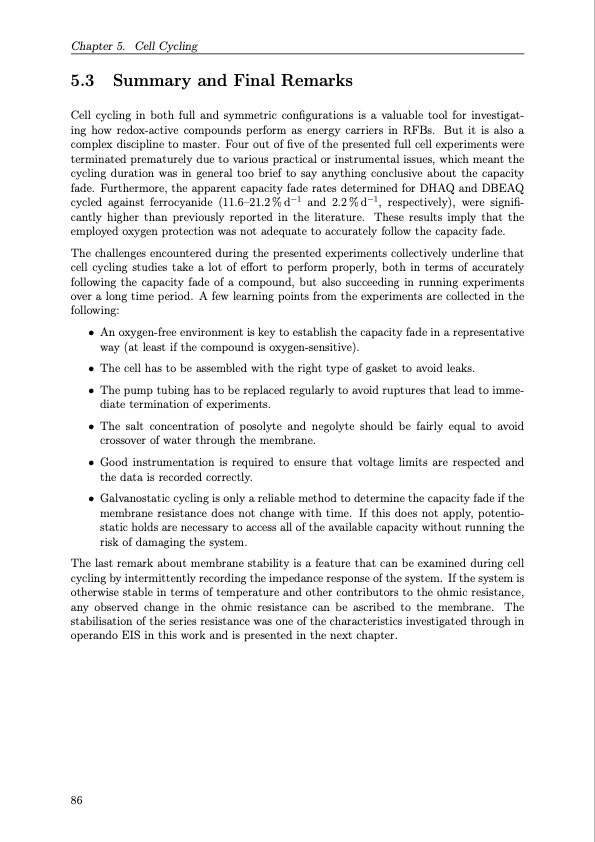
PDF Publication Title:
Text from PDF Page: 107
Chapter 5. Cell Cycling 5.3 Summary and Final Remarks Cell cycling in both full and symmetric configurations is a valuable tool for investigat- ing how redox-active compounds perform as energy carriers in RFBs. But it is also a complex discipline to master. Four out of five of the presented full cell experiments were terminated prematurely due to various practical or instrumental issues, which meant the cycling duration was in general too brief to say anything conclusive about the capacity fade. Furthermore, the apparent capacity fade rates determined for DHAQ and DBEAQ cycled against ferrocyanide (11.6–21.2 % d−1 and 2.2 % d−1, respectively), were signifi- cantly higher than previously reported in the literature. These results imply that the employed oxygen protection was not adequate to accurately follow the capacity fade. The challenges encountered during the presented experiments collectively underline that cell cycling studies take a lot of effort to perform properly, both in terms of accurately following the capacity fade of a compound, but also succeeding in running experiments over a long time period. A few learning points from the experiments are collected in the following: • An oxygen-free environment is key to establish the capacity fade in a representative way (at least if the compound is oxygen-sensitive). • The cell has to be assembled with the right type of gasket to avoid leaks. • The pump tubing has to be replaced regularly to avoid ruptures that lead to imme- diate termination of experiments. • The salt concentration of posolyte and negolyte should be fairly equal to avoid crossover of water through the membrane. • Good instrumentation is required to ensure that voltage limits are respected and the data is recorded correctly. • Galvanostatic cycling is only a reliable method to determine the capacity fade if the membrane resistance does not change with time. If this does not apply, potentio- static holds are necessary to access all of the available capacity without running the risk of damaging the system. The last remark about membrane stability is a feature that can be examined during cell cycling by intermittently recording the impedance response of the system. If the system is otherwise stable in terms of temperature and other contributors to the ohmic resistance, any observed change in the ohmic resistance can be ascribed to the membrane. The stabilisation of the series resistance was one of the characteristics investigated through in operando EIS in this work and is presented in the next chapter. 86PDF Image | Organic Redox Flow Batteries 2023

PDF Search Title:
Organic Redox Flow Batteries 2023Original File Name Searched:
PhD_thesis_final_dorhoff_4_.pdfDIY PDF Search: Google It | Yahoo | Bing
Salgenx Redox Flow Battery Technology: Salt water flow battery technology with low cost and great energy density that can be used for power storage and thermal storage. Let us de-risk your production using our license. Our aqueous flow battery is less cost than Tesla Megapack and available faster. Redox flow battery. No membrane needed like with Vanadium, or Bromine. Salgenx flow battery
| CONTACT TEL: 608-238-6001 Email: greg@salgenx.com | RSS | AMP |